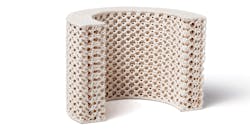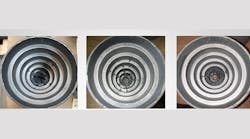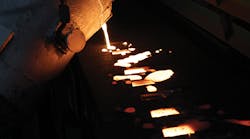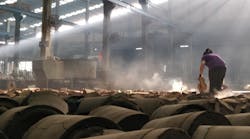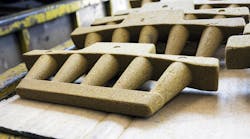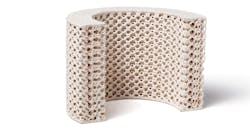Q: We pour medium- to large-size gray, ductile, and CGI castings, and we are evaluating our current gray- and ductile-iron tapping, treating, inoculating and pouring processes. Is there a process/practice that would allow us to automate treating and inoculating processes effectively?
A: There are many different processes for treating and inoculating cast iron, processes that usually are conducted at the ladle. Tundish, pour-over, and sandwich methods are typical. More automated processes include plunging and the gazelle (porous plug) methods, while for inoculation the in-stream process is automated easily and provides many benefits.
However, one approach can apply both automated treatment and inoculation practice. Cored-wire practice introduces a hollow wire filled with powder alloys to the molten metal. The alloys in the wire may be MgFeSi for magnesium treatment (for DI or CGI), and/or inoculation material (for DI, GI or CGI.)
The wire is drawn from a coil that is mounted to the machine and feeds it to the molten metal. After it is set up, the machine has a human-machine interface (HMI) for installing required values of the melt and to introduce process automation. With these input values the machine will calculate the length of wire necessary to feed into the metal. Because this process is automated, it brings more accuracy to the sequence of adding magnesium and inoculation materials.
These values are necessary to calculate how much wire is required in the molten metal. The coil normally reports the alloys in grams per meter of wire, and the information required by the computer will allow it to accurately calculate the length of the wire necessary to add the right amount of alloy.
The input values include sulfur content before and after treatment (for DI and CGI), iron volume, melt temperature, and wire-feeding speed. Some additional inputs may be required, but this will vary according to the current practice.
Normally, recovery levels of cored wire are comparable to other practices, however it will depend on a number of things: sulfur content before and after magnesium treatment, the percent of magnesium content in the treated iron, the iron quantity, the meters of wire fed, and the quantity of magnesium per meter of wire. With these details, a preliminary percentage of magnesium recovery can be calculated.
The temperature of the metal and the ladle geometry also affect magnesium recovery, and results will depend upon each individual practice.
For cored-wire practice it is preferable for the ladle to be taller than it is wide. Usually, a ladle that has a height/diameter ratio of 2:1 is recommended for cored-wire practice. This will promote a high iron column, meaning the Mg vapor bubbles have to travel a long distance through the iron and therefore remain largely within the iron.
However, it is possible to use your current ladles: The cored-wire mechanism can be tailored to any ladle as long as this is considered when designing the equipment.
Cored-wire practice offers reproducible results between ladles, high-quality iron, and simple process automation. In addition to these benefits, cored-wire treatment also can be an environmentally friendly process. The mechanism normally includes a lid with hollow tubes through which to introduce the wire: one of these tubes is used to control and direct the emissions from the treatment and inoculation step into the fan. With this system, it is easy to control the effluent and prevent the smoke from the magnesium treatment to disturb other activities in the foundry.
The typical products for ductile iron treatment and inoculation are MgFeSi and foundry-grade FeSi. However, we also offer pure magnesium wires and other inoculation products, such as ferrosilicon with zirconium, strontium, aluminum, calcium, bismuth and even cerium. Your selection depends on what you seek to accomplish at your foundry.
There also are different wire diameters that may be chosen for cored-wire practice. Standard diameters for wire are 9 and 13 mm, available for the different cored wire coils. On special occasions, a 16-mm diameter wire may be offered.
The different diameters will ensure that more material can be inserted per meter of wire. The larger diameters provide the ability to use less coil length, and also may reduce the wire-feeding speed for the mechanism.
Join the Conversation. Email Your Questions for ASK Chemicals
Share your insights or opinions, and elaborate on the experts’ answers. You must be logged in to the website to post your comments.
